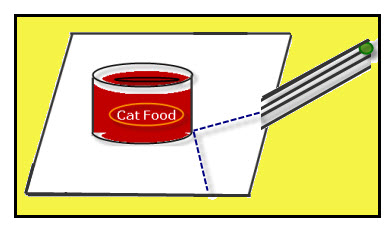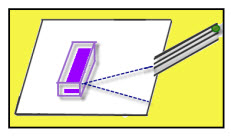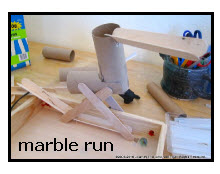I am a visual learner and often make models so that I can understand a concept. Since I seem to be challenged when it comes to spacial orientation, I need models for things that are three dimensional. For example, atoms and their parts and especially how scientists find out about the parts of atoms without seeing the parts. One technique is by collecting indirect evidence. Here is where I need a model, such as diagrams.
But a hands-on experiment is also a model. For example, in the following investigation, you will not be experimenting with atoms. Instead, you will be modeling how scientists might discover the composition of an atom by shooting particles at the atom. How the particles behave gives clues about the size and shape of objects inside an atom.
Discover for Yourself
 If you roll a marble toward a solid object, the marble will bounce off of the object.
If you roll a marble toward a solid object, the marble will bounce off of the object.
Does the shape of the object the marble strikes affect how it is reflected?
The diagrams show the angle to be larger if the object is round and smaller if the object is flat. Is this always true? Maybe other factors are involved, such as the angle at which the marble strikes the object. Test this for yourself.
Materials
2 short cans, 1-round, 1-rectangular (tuna and sardine cans can be used)
ruler with center groove
marble
large sheet of paper, such as posterboard
Procedure
1. Lay the paper on a flat surface, such as a table or floor.
2. Set the round can in the center of the paper.
3 Place one end of the ruler on the paper, and then raise the opposite end of the ruler about 4 inches.
4. Holding the ruler in line with the can and at a slant to the top of the table, place the marble in the groove at the top of the ruler.
Note: Instruction for a more stable marble run can be found
HERE.See diagrams below.
5. Release the marble and allow it to roll down the ruler. Observe the path of the marble on the paper before and after it hits the can. Ask a helper to observe, and then to mark the path of the marble.
6. Move the ruler so that the marble will strike the can at a different place, and then repeat steps 3 through. Repeat this step until you have path’s marked from points around the can. Note: It is important to try and make each test the same. This means to raise the ruler to the same height as well as the distance the ruler edge is from the base of the can.
7. Repeat steps 3 through 6 using the rectangular can. You can turn the paper over so that you have a clean surface to mark the marble’s paths on. Compare how the marble moves when it hits the two different shapes.
Using Indirect Data
Materials
poster board
cans used in previous investigation
ruler and marble from previous investigation
box at least 6 inch x 6 inch x 2 inch (ask adult to cut a box if needed)
Procedure
1. Place the clean piece of poster board on a flat surface as before.
2. Without your seeking the selection, ask someone to choose one of the cans and place it in the center of the paper. Your helper needs to cover the can with the box so that the bottom of the box sits on top of the can and the sides of the box cover the can from view. If you can see the can, you need another cover–maybe a larger box with taller sides.
3. Repeat steps 3 through 5 of the previous investigation. Use the results to determine if the can is round or has flat sides. and
This is a very simple demonstration of how information can be obtained without seeing or touching and object. In fact, these investigations are similar to to how in 1918 Ernest Rutherford discovered that atoms have protons. Rutherford’s first investigation was shooting alpha particles (positive particles) into hydrogen gas. He had a device that recorded the path of the alpha particles. Some went straight through–a straight line, while other seem to be deflected in different directions. Later he repeated the experiment using nitrogen gas. The results were the same. How could the nitrogen nuclei have a hydrogen nuclei inside them??? His conclusion was that each hydrogen nuclei was an elementary particle. He named this particle proton, from the Greek word protos, for “first. His guess–hypothesis–was partially correct. It was something in the nuclei of hydrogen atoms that was also in nitrogen nuclei, which was a positive particle. It is still called a proton.
You might like these Ideas from “Journey Into UnSchooling.Com”
For a 20% Discount on Book Purchases, Use Code AFF20
l

